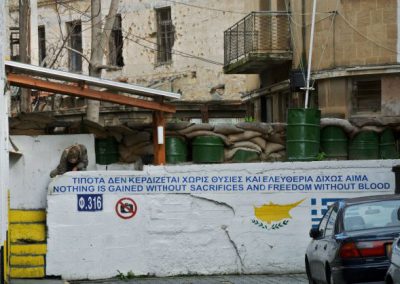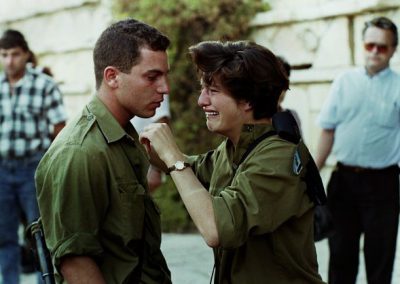Divided Cities 1973-2015
The archive depicts how divided cities in Europe and the Middle East have been shaped and re-shaped by ethnic, religious and national conflicts over this ongoing period of time. It commences in Belfast in 1973 and continues, contrasting his experiences in Berlin at the fall of the Wall (1989), Jerusalem’s Intifada (1990-91) and Nicosia’s Green Line (2015-16).

The Nicosia UN Buffer Zone pictured 2015.
he Buffer runs through the middle of the city and the historic centre itself.
A female Jewish settler and member of the Kach radical Orthodox Jewish, ultranationalist political party pictured in Israel 1990. The Arab-Israeli conflict is a struggle over land, history and religion. It’s also a dispute over who owns Jerusalem and its holy sites. 1990
Preaching at the Damascus gate. Daily life goes on in and around Jerusalem, the divided city. Pictures created in 1990 as part of the Divided Cities project, show Jews and Arabs carrying on with everyday chores despite the presence of the Palestinian second intifada.
The Nicosia UN Buffer Zone pictured 2015.
Nicosia remains the last divided capital in Europe. The ‘Green Line’ splits Cyprus and Nicosia in two. The Buffer Zone, running through the middle of the city and the historic centre itself, has undermined its centrality and turned it into a “border” town.
Turkish forces built a barrier on the zone’s northern side, consisting mainly of barbed-wire fencing, concrete wall segments, watchtowers, anti-tank ditches, and minefields. Nicosia remains the last divided capital in Europe.
A member of the Israeli defense force IDF pictured at the funeral of a colleague killed during the Intidada 1990.
Belfast’s Loyalist Sandy Row Area. The kerb stones are painted Red, White and Blue to reflect the British tradition of the residents. 1989
CONTACT
Get in touch on: martin.nangle@rocketmail.com or +44 (0) 7 56 55 49 557

















